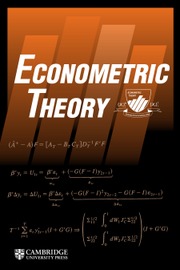Article contents
ESTIMATION OF STOCHASTIC VOLATILITY MODELS BY NONPARAMETRIC FILTERING
Published online by Cambridge University Press: 13 April 2015
Abstract
A two-step estimation method of stochastic volatility models is proposed: In the first step, we nonparametrically estimate the (unobserved) instantaneous volatility process. In the second step, standard estimation methods for fully observed diffusion processes are employed, but with the filtered/estimated volatility process replacing the latent process. Our estimation strategy is applicable to both parametric and nonparametric stochastic volatility models, and can handle both jumps and market microstructure noise. The resulting estimators of the stochastic volatility model will carry additional biases and variances due to the first-step estimation, but under regularity conditions we show that these vanish asymptotically and our estimators inherit the asymptotic properties of the infeasible estimators based on observations of the volatility process. A simulation study examines the finite-sample properties of the proposed estimators.
- Type
- ARTICLES
- Information
- Copyright
- Copyright © Cambridge University Press 2015
Footnotes
The authors wish to thank Bruce Hansen, Bent Nielsen, Neil Shephard, Yoshinori Kawasaki, Kotaro Hitomi, Yoshihiko Nishiyama, Russell Davidson, Howell Tong, Pascale Valery and Karim Abadir for fruitful discussions and helpful suggestions. They also wish to thank participants at seminars at University of Wisconsin-Madison, the CREATES opening Conference, the 2007 EC2 Meeting, the 2009 Japanese Statistical Society Spring Meeting, the 4th London and Oxbridge Time Series Workshop, the 43rd Annual Conference of the Canadian Economics, the 2009 North American Summer Meeting of the Econometric Society, and the 2009 Far East and South Asia Meeting of the Econometric Society for comments and suggestions. They also gratefully acknowledge support from CREATES, Center for Research in Econometric Analysis of Time Series, funded by the Danish National Research Foundation (DNRF78). Kristensen gratefully acknowledges financial support from the National Science Foundation (grant no. SES-0961596). Part of this research was conducted while Kanaya was visiting the Institute of Statistical Mathematics and the Institute of Economic Research at Kyoto University (under the Joint Research Program of the KIER), and Kristensen was visiting Princeton University and University of Copenhagen, whose support and hospitality are gratefully acknowledged.
References
REFERENCES
- 35
- Cited by




